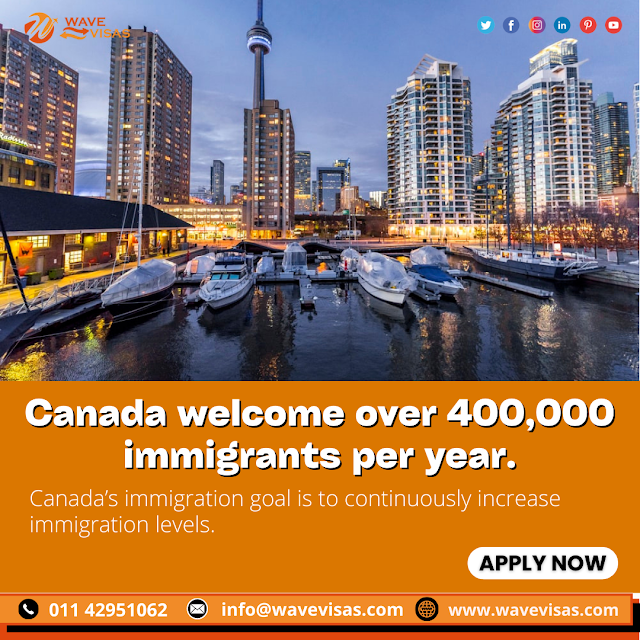Why does Canada welcome over 400,000 immigrants per year?
Immigration Canada's goal is to continuously increase the number of immigrants to strengthen the economy, unite families and provide humanitarian assistance to refugees.
Immigration to Canada is divided into three categories:
· Economic Class
· Family Class
· Refugee Class
The economic category includes immigrants selected on the
basis of their ability to contribute to the Canadian economy, whether through
their ability to meet labour market needs, own or run a business, make a
significant investment, or own a job.
The family category includes immigrants sponsored by Canadian
citizens or permanent residents. The goal is for family members and couples to
meet and live together in Canada. These immigrants are granted permanent
resident status because of their relationship to their spouse, partner, parent,
grandparent, child or other relative.
The economic class
includes immigrants who have been granted settlement permits for fear of
persecution based on their race, religion, nationality, membership in a
particular social group, or political opinion. This category also includes
persons who have been severely affected by war or conflict or who have suffered
serious human rights violations.
Economic and employment growth has been slow due to Canada's
aging population and low birth rate. Slow economic growth has made it difficult
for Canada to raise taxes on social services such as education and health care.
Because of this, Canada has increased immigration to boost the country's
economy and finances.
Every year, the federal government releases a new phased
immigration plan outlining immigration goals for the next three years. The plan
includes the number and types of immigrants the country is expected to receive.
By 2022, Canada is expected to add more than 430,000 new permanent residents,
with nearly 60% of new permanent residents in economy class.
Economic Class:
The most common economy class entry in Canada is through the
federal Express Entry system. Eligible candidates, usually skilled workers,
submit their profiles and receive a score, which is ranked by the Comprehensive Ranking System (CRS).
Every two weeks, Immigration, Refugees
and Citizenship Canada (IRCC) invites the highest-scoring qualified
candidates to apply for permanent residence.
The Express Entry system manages three programs, the Federal Skilled Worker Program (FSWP),
the Federal Skilled Worker Class
(FSTC), and the Canadian Experience
Class (CEC). The FSWP is Canada's primary way of welcoming skilled workers
from around the world. It uses CRS, a points-based system that calculates based
on age, education, work experience, language skills, and more.
The FSTC is designed to address the skilled labour shortage
in Canada. These candidates may have lower scores because they are not required
to demonstrate their level of education, but IRCC occasionally conducts
fast-track draws for specific programs and invites only FTSP candidates to
participate. These successful candidates can usually be granted permanent
residency within six months. Finally, the CEC is for candidates who work in
Canada and wish to obtain permanent residency. This option is for temporary
foreign workers and international graduates who wish to continue building their
future in Canada.
The Provincial NomineeProgram (PNP) is another major option for immigrating to Canada as a
skilled worker. The purpose of this program is to spread the benefits of
immigration throughout Canada. As a result, nearly every province and territory
uses the PNP to attract and welcome skilled workers from around the world to
help strengthen Canada's economy. The only exceptions are Nunavut and Quebec.
Instead, Quebec has its own eligibility criteria for economic
immigration, starting with candidates expressing interest in immigrating to
Quebec by submitting an Expression of
Interest (EOI) form.
The Family Class:
IRCC also welcomes immigrants through family sponsorship. If
you are a Canadian citizen or permanent resident, you can sponsor your foreign
spouse or partner for Canadian permanent resident status. Sponsorships can
occur regardless of whether the sponsor resides abroad or in Canada, as couples
can choose between foreign or domestic sponsorship. As a sponsor, you must be
able to support your spouse or partner financially and meet that person's basic
needs. IRCC also requires you to prove that the relationship is genuine.
Canadian citizens or permanent residents can also sponsor
dependent children to live with them as Canadian permanent residents. For
children to be eligible for sponsorship, they must be natural or adopted
children of Canadian citizens or permanent residents, under the age of 22, and
not married or living together. Similar to a spousal sponsorship, the sponsor
must meet the basic needs of the child.
Additionally, Canadian citizens and permanent residents can
sponsor their parents and grandparents to immigrate to Canada. Parents and
grandparents who come to Canada through this program gain permanent resident
status and can apply for Canadian citizenship. Sponsors must exceed the
program’s minimum income requirements and agree to provide financial support to
the sponsor and repay all social benefits paid to sponsor family members within
20 years. Applicants to the program must also demonstrate that they meet the
minimum income requirements.
The Refugee Class:
People can immigrate to Canada through refugee classes or for
humanitarian reasons. Resettled refugees are immigrants selected by the United
Nations High Commissioner for Refugees outside their country of origin who have
been granted permanent residency in Canada. Canada provides them with a haven
free from persecution, human rights abuses or war. In addition, refugees landed
in Canada can apply for asylum and be approved by the Immigration and Refugee
Board. Permanent resident status is available to those who do not fall into the
above categories but who convincingly defend humanitarian and compassionate
grounds.

.png)
.png)
.png)
Comments
Post a Comment